[OS] Synchronization Examples
[toc]
Chapter 7: Synchronization Examples
- Classic Problems of Synchronization
- the bounded-buffer synchronization problem
- the readers-writers synchronization problem
- The dining-philosophers synchronization problems
- Synchronization within the Kernel
- the tools used by Linux and Windows to solve synchronization problems.
- POSIX Synchronization
- Synchronization in Java
- Alternative Approaches
Classical Problems of Synchronization
- Classical problems used to test newly-proposed synchronization schemes
- Bounded-Buffer Problem
- Readers and Writers Problem
- Dining-Philosophers Problem
Bounded-Buffer Problem
- n buffers, each can hold one item
- producer와 consumer간의 shared buffer
- in, out index로 조절 - full, empty 판단
- 혹은 count 변수로
- Semaphore mutex initialized to the value 1 - binary semaphore
- critical section의 진입 -> 0으로 초기화하면 영원히 못들어감!
- binary semaphore
- Semaphore full initialized to the value 0
- 차있는 slot의 갯수
- count semaphore -> 0~n
- Semaphore empty initialized to the value n
- 비어있는 slot의 갯수
- count semaphore -> 0~n
- semaphore
- 개발자, hardware의 도움이 아닌 OS의 도움!
Bounded Buffer Problem (Cont.)
- The structure of the producer process
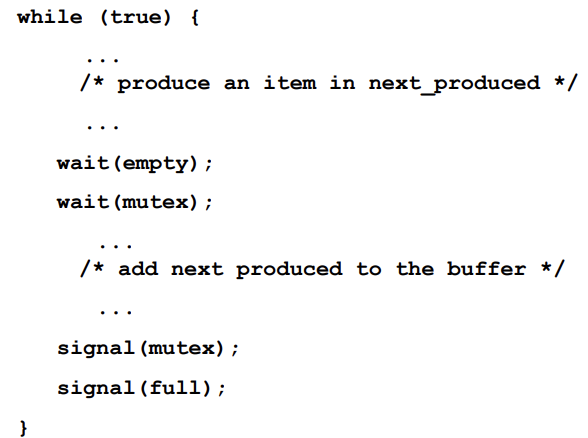
-
common buffer에 삽입하는 부분이 CS임 (add next …)
- produce가 CS에 들어가면 consumer는 못 들어감
- wait(empty) - 빈 slot이 없으면 대기(block)
- empty의 값이 0에서 1로 바뀔 때까지
- empty의 값이 있기를 기다림 -> 빈 slot이 있기를 기다림
- wait(mutex)
Bounded Buffer Problem (Cont.)
- The structure of the consumer process
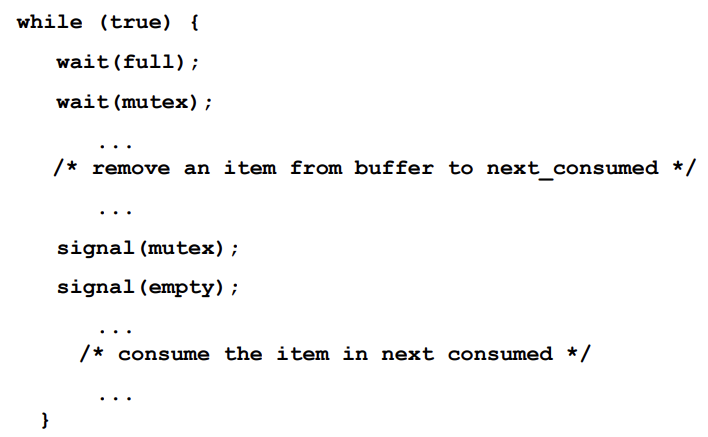
- 꺼내오려는데 꺼내올 것이 없으면 대기해야 하기 때문에 wait(full) 값이 0이면 wait한다.
- full의 값이 있기를 기다림
Readers-Writers Problem
- A data set is shared among a number of concurrent processes
- Readers – only read the data set; they do not perform any updates
- 읽기만 하는 process
- 여러개가 동시에 있어도 OK
- Writers – can both read and write
- 읽기도 하고 쓰기도 하는 프로세스
- 오직 한 process만 가능
- readers와 writers가 동시에 있는 것도 불가능
- 즉 writer가 있으면 무조건 걔만 딱 하나 있어야 함.
- Readers – only read the data set; they do not perform any updates
- Determine need for mutex based on nature of processes
- Readers : allow multiple readers can read data simultaneously
- Writers : Only one single writer can access the shared data at the same time
- restrict to 1 at a time (mutex)
- Also writers should have exclusive access to data
- Should not have reader reading while writer is writing
- Readers in CS should block writers from entering CS
- Writers in CS should block readers and other writers from entering CS
- Several variations of how readers and writers are considered – all involve some form of priorities
Readers-Writers Problem (Cont.)
-
Shared Data
-
Data set
-
Semaphore rw_mutex initialized to 1 // rw_mutex functions as a mutex semaphore
// for writers. used by first or last reader
// that enters or exists cs
- 1) writers끼리 경쟁
-
- reader vs. writer
- writer가 경쟁하는 것은 first reader
- 첫번째 reader가 들어가면 그 다음 reader는 계속 들어가지기 때문에
- 진입제어 용
-
Semaphore mutex initialized to 1 // mutex is used to ensure mutex when
// read_count is updated
- read_count가 바뀔 때 atomic 함을 보장해 주기 위해
-
Integer read_count initialized to 0
- critical section에 진입을 시도하는 reader process의 갯수
- read_count 값을 바꾸는 과정이 atomic하지 않는다.
- 그래서 mutex로 감싸서 atomic operation을 보장한다.
-
-
The structure of a writer process
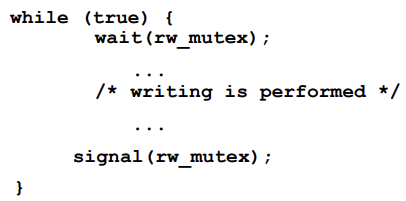
- rw_mutex 값을 1로 초기화
- critical section을 빠져나오면서 signal(rw_mutex)를 통해 rw_mutex 값이 0에서 1로 바뀌어야지 다른 것들이 들어갈 수 있게 됨.
- queue를 통해 FCFS 보장
Readers-Writers Problem (Cont.)
- The structure of a reader process
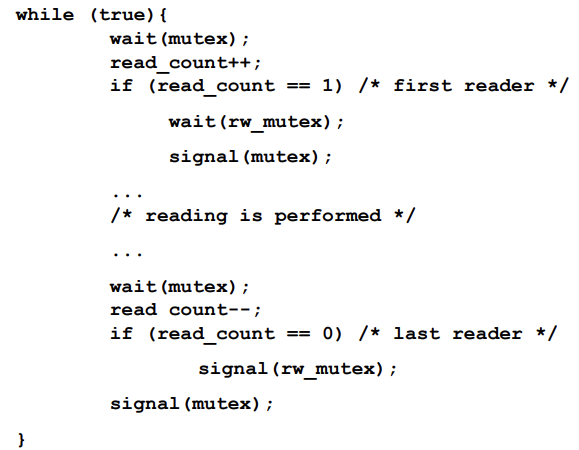
- reader가 하나 들어가면 read_count값을 하나 증가시킨다.
- mutex는 read_count 변수를 update할 때 atomic operation를 보장하기 위해서이므로 wait(mutex) 후에read_count 값을 바꿀 수 있다.
- read_count == 0
- CS에 존재하는 reader가 없다.
- CS를 빠져 나오는 reader가 0
- signal(rw_mutex) -> 0
- 이제 writer가 들어갈 수 있음
- read_count 가 2를 넘어서면 rw_mutex 값을 바꾸지 않기 때문에 계속 들어갈 수 있음
Readers-Writers Problem Variations
- The solution in previous slide can result in a situation where a writer process never writes. It is referred to as the “First reader-writer” problem.
- First variation - Reader’s priority(reader에게 유리함)
- 만약 최초의 CS 진입 경쟁을 할 때 reader가 이겨서 reader가 들어갔다면 그 후에 reader는 계속 들어갈 수 있지만 writer는 못들어감(rw_mutex 값은 read_count가 ==0 일 때만 변경 되기 때문에 )
- no reader kept waiting unless writer has permission to use shared object
- No reader should wait simply because a writer is ready
- Readers obtain access to CS when needed
- Only block if writer has access to CS
- Writers may starve
- -> 근데 writer에게 유리하게 코드를 바꿀 수 있음
- Second variation - Writer’s priority
- writer와 reader가 경쟁하면 무조건 writer에게 우선순위
- once writer is ready, it performs the write ASAP
- writer님이 들어가고 싶어하십니다! -> reader들은 못들어감
- If a writer is waiting to access a object, no new readers may start reading
- Readers may starve
- Both may have starvation leading to even more variations
- Problem is solved on some systems by kernel providing reader-writer locks
Dining-Philosophers Problem

- Philosophers spend their lives alternating thinking and eating
- Don’t interact with their neighbors, occasionally try to pick up 2 chopsticks (one at a time) to eat from bowl
- Need both to eat, then release both when done
- 젓가락 두 개를 모두 집어야 식사 가능 -> 식사 후에 젓가락 내려놓기 가능
- 한 번에 하나의 젓가락만 집을 수 있음
- Need both to eat, then release both when done
- In the case of 5 philosophers
- Shared data
- Bowl of rice (data set)
- Semaphore chopstick [5] initialized to 1
- binary semaphore
- Shared data
Monitor with condition variables
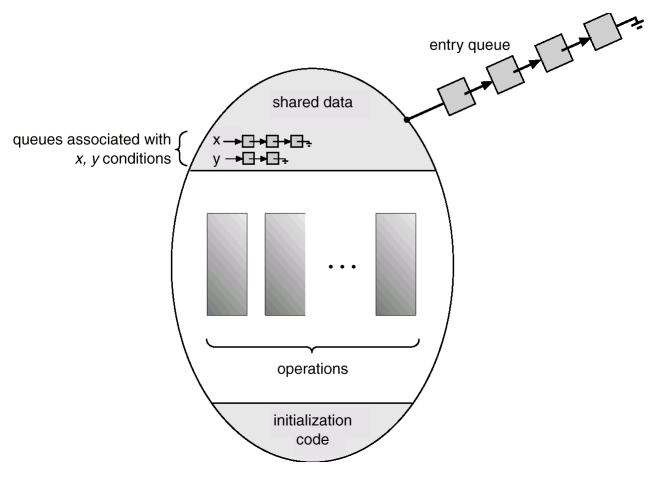
-
2개 이상의 process가 monitor 안에서 실행되면 동기화 자체에 문제가 생긴다.
- initialization code: monitor가 만들어질 때 딱 한 번 실행됨
- shared data 초기화
-
사용 중인 모니터에 접근하기를 원해서 대기 중인 프로세스들은 entry queue에서 대기한다.
-
해당 condition을 기다리는 프로세스들은 condition queue에서 대기한다.
- next queue의 역할?
- 다른 프로세스가 모니터 내부에 있어서 잠시 대기하는 큐
- 모니터 내부 작업 중에 잠시 프로세스가 대기하는 큐
- 제일 우선순위 높은 ; next queue, entry queue, 새로들어온 애
- condition queue는 next queue나 entry queue와는 비교 대상이 아님
- condition이 만족해야만 깨어날 수 있기 때문
- condition queue는 next queue나 entry queue와는 비교 대상이 아님
Dining-Philosophers Problem Algorithm
-
Semaphore Solution
-
The structure of Philosopher i :
while (true){ wait (chopstick[i] ); wait (chopStick[ (i + 1) % 5] ); /* eat for awhile - critical section*/ signal (chopstick[i] ); signal (chopstick[ (i + 1) % 5] ); /* think for awhile */ } -
What is the problem with this algorithm?
- 모든 다섯명의 철학자가 첫 코드를 실행했다고 했을 때 -> 모두가 젓가락 하나씩을 집으려고 할 때
- 그 다음 코드를 실행하지 못할 것이기 때문에 deadlock 발생 (코드가 진행이 안 됨)
- deadlock이 발생하지 않도록 semaphore로 해결할 수도 있음
- 모든 다섯명의 철학자가 첫 코드를 실행했다고 했을 때 -> 모두가 젓가락 하나씩을 집으려고 할 때
- 간단한 솔루션 -> semaphore 사용
- 철학자는 그 semaphore에 wait()연산을 실행하여 젓가락을 집으려고 시도
- signal()연산을 수행하여 자신의 젓가락을 내려 놓음
- 공유 데이터: 밥그릇 (데이터 셋)
- 1로 초기화된 semaphore -> chopstick[5]
- 인접한 두 철학자가 동시에 식사하지 않음을 권장
- 그러나 모두가 동시에 자신의 왼쪽 젓가락을 집는다면?? -> deadlock 발생!
- 해제가 되려면 누군가는 오른쪽 젓가락을 집어야 되는데 아무도 해제가 될 상황이 없기 때문.
- 해결안 1)
- 최대 4명의 철학자들만이 테이블에 동시에 앉을 수 있도록 함
- 해결안 2)
- 한 철학자가 젓가락 두 개를 모두 집을 수 있을 때만 젓가락을 집도록 허용
- 해결안 3)
- 비대칭 해결안 사용. 홀수 번호의 철학자는 왼쪽 젓가락부터, 짝수 번호의 철학자는 짝수 젓가락부터 집을 수 있다는 rule 적용
Monitor Solution to Dining Philoshophers
monitor DiningPhilosophers
{
enum { THINKING; HUNGRY, EATING) state [5] ;
condition self [5];
void pickup (int i) { // wait에 해당하는 부분
state[i] = HUNGRY;
test(i); // 왼쪽 오른쪽 젓가락 확보를 위한 작업
if (state[i] != EATING) self[i].wait;
}
void putdown (int i) { //signal에 해당하는 부분
state[i] = THINKING;
// test left and right neighbors - 내 좌우 사람들 중 나때문에 못먹던 사람 깨우기
test((i + 4) % 5);
test((i + 1) % 5);
}
void test (int i) { // private 함수(내부용)
if ((state[(i + 4) % 5] != EATING) && // 나의 왼쪽 철학자가 먹지 않고 있으면서
(state[i] == HUNGRY) && // 내가 HUNGRY 상태 이면서
(state[(i + 1) % 5] != EATING) ) // 나의 오른쪽 철학자가 먹지 않고 있을 때!
{
state[i] = EATING ;
self[i].signal () ;
}
}
initialization_code() { // 생성자
for (int i = 0; i < 5; i++)
state[i] = THINKING; // CS 진입을 시도하지 않은 상태로 초기화
}
}
- monitor instance (앞에 class가 붙었으면 class instance였을 것임)
- EATING 상태 - CS에 진입한 상태
- HUNGRY 상태 - CS에 진입하려는 상태
- 젓가락 확보를 위해 경쟁하고 있는
- test 함수
- 내가 밥을 먹으면 내 옆의 철학자는 eating으로 바뀌지 않고 self.wait으로 condition queue에 들어가지기 때문에 즉, wait하고 있기 때문에 마지막에 self[i].signal을 해 주어 깨워준다.
- 깨어나면 pickup을 넘어갈 수 있기 때문에 critical section인 EAT에 도달할 수 있는 것이다.
- pickup()
- 진입을 시도하기 때문에 HUNGRY로 상태를 바꿈.
- 상태가 EATING이 아니면 self[i].wait
- condition 변수 - self[i].wait
- 다른 사람이 self[i].signal을 해야 살아남
Solution to Dining Philosophers (Cont.)
- Each philosopher “i” invokes the operations pickup() and putdown() in the following sequence:
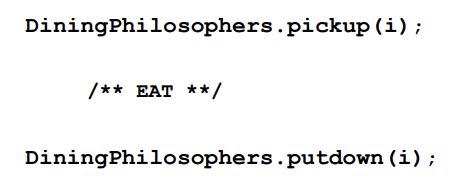
- No deadlock, but starvation is possible
- 도착 순서에 의해서 젓가락을 잡을 수 있는 것이 아니기 때문에 일찍 hungry해도 eating하지 못할 수 있다.
- mutex 보장
- 옆사람하고 나하고 동시에 젓가락을 잡는 경우가 생기지 않음
- progress
- CS밖에 있는 process 때문에 CS에 못들어가는 일이 발생하지 않음
- bounded waiting
- 실패를 하더라도 어느정도 시간 안에 들어가는 것이 보장
- 위 세가지 조건 모두 만족! by OS
A monitor to allocate single resource
Monitor ResourceAllocation {
boolean busy;
condition x;
void acquire (int time){
if (busy) //resource가 하나밖에 없는데 이미 할당되어져 있는 경우
x.wait(time);
busy = true;
}
void release() {
busy = false;
x.signal();
}
void init() {
busy = false;
}
}
ResourceAlocation R;
R.acquire(t);
access the resource //자원 사용 가능
R.release();
Synchronization Examples - 나 같으면 안 낼 듯…
- Solaris
- Windows
- Linux
- Pthread
- Java
Solaris Synchronization - XXXX
- Implements a variety of locks to support multitasking, multithreading (including real-time threads), and multiprocessing
- Uses adaptive mutexes for efficiency when protecting data from short code segments
- Starts as a standard semaphore spin-lock - 기본적으로는 spinlock
- If lock held, and by a thread running on another CPU, spins
- If lock held by non-run-state thread, block and sleep waiting for signal of lock being released
- 이게 금방 풀릴 것 같지 않으면 일반적인 semaphore로 동작!
- Uses condition variables and readers-writers locks when longer sections of code need access to data
- Uses turnstiles to order the list of threads waiting to acquire either an adaptive mutex or reader-writer lock
- Turnstiles(회전문) are per-lock-holding-thread, not per-object
- 먼저 들어온 사람이 먼저 lock 획득
- Priority-inheritance per-turnstile gives the running thread the highest of the priorities of the threads in its turnstile
- 어떤 lock에 대해 소유권의 우선순위가 높은 프로세스가 있는데 현재 lock을 소유하고 있는 프로세스는 그것보다 우선순위가 낮을 때 이 우선순위가 낮은 프로세스가 release를 해야 우선순위가 높은 프로세스가 사용하므로
- 높은 우선순위의 프로세스의 우선순위를 낮은 우선순위의 프로세스에게 잠시 빌려준다!
- 너 이거 빌려줄테니까 빨리 끝내라 !
- 높은 우선순위의 프로세스의 우선순위를 낮은 우선순위의 프로세스에게 잠시 빌려준다!
- 어떤 lock에 대해 소유권의 우선순위가 높은 프로세스가 있는데 현재 lock을 소유하고 있는 프로세스는 그것보다 우선순위가 낮을 때 이 우선순위가 낮은 프로세스가 release를 해야 우선순위가 높은 프로세스가 사용하므로
- Uses readers-writers locks when longer sections of code need access to data
Kernel Synchronization - Windows -XXXX
- Uses interrupt masks to protect access to global resources on uniprocessor systems
- Uses spinlocks on multiprocessor systems
- Spinlocking-thread will never be preempted
- Also provides dispatcher objects user-land which may act mutexes, semaphores, events, and timers
- The kernel defines a set of object types called kernel dispatcher objects, or just dispatcher objects.
- Dispatcher objects include timer objects, event objects, semaphore objects, mutex objects, and thread objects.
- Events
- An event acts much like a condition variable
- Timers notify one or more thread when time expired
- Dispatcher objects either signaled-state (object available) or non-signaled state (thread will block)
- Every kernel-defined dispatcher object type has a state that is either set to Signaled or set to Not-Signaled.
- Mutex dispatcher object

어떤 thread가 lock을 획득하면 nonsignaled로 바뀌고 release하면 다시 signaled 상태로 바뀐다.
Linux Synchronization-XXXX
- Linux:
- Prior to kernel Version 2.6, Linux was a non-preemptive kernel
- disables interrupts to implement short critical sections
- Version 2.6 and later, fully preemptive
- A task can be preempted when it is running in kernel
- Prior to kernel Version 2.6, Linux was a non-preemptive kernel
- Linux provides:
- atomic integers
- spinlocks
- semaphores
- reader-writer versions of both (spinlock, semaphores)
- On single-CPU system, spinlocks replaced by enabling and disabling kernel preemption
-
atomic variables
-
atomic_t is the type for atomic integer (data type)
-
Simplest synchronization tool within Linux kernel
-
All math operations using atomic integers are performed without interruption
-
Atomic operations do not need the overhead of locking mechanism
-
atomic_t counter;
-
int value

mutex_lock, spin_lock
-
Mutex lock is used to protect critical sections within kernel
mutex_lock()
critical section // sleep is possible
mutex_unlock()
-
Reader-writer version
-
Spin lock & semaphore are used for locking in the kernel
- On SMP machine, spinlock is a fundamental locking mechanism
- On single-CPU system, spinlocks is not inappropriate
- enabling and disabling kernel preemption

Pthread (POSIX) Synchronization
이거는 user level에서의 synchronization 문제 해결하는 tool
- Pthreads API is OS-independent user level threads
- Widely used on UNIX, Linux, and macOS
- It provides:
- mutex locks
- Semaphore (named, unnamed)
- condition variable
- Non-portable extensions include:
- read-write locks
- spinlocks
POSIX Mutex Locks
- Fundamental synchronization tool used with Pthreads
- Creating and initializing the lock

- Acquiring and releasing the lock

POSIX Semaphores
- POSIX provides two versions – named and unnamed.
- Named semaphores can be used by unrelated processes, unnamed cannot.
POSIX Named Semaphores
- Creating an initializing the semaphore:

- Another process can access the semaphore by referring to its name SEM.
- Acquiring and releasing the semaphore:

POSIX Unnamed Semaphores
- Creating an initializing the semaphore:

- Acquiring and releasing the semaphore:
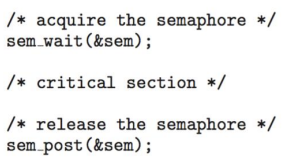
POSIX Condition Variables
- Since POSIX is typically used in C/C++ and these languages do not provide a monitor, POSIX condition variables are associated with a POSIX mutex lock to provide mutual exclusion: Creating and initializing the condition variable:
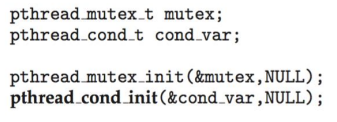
POSIX Condition Variables
- Thread waiting for the condition a == b to become true:

- Thread signaling another thread waiting on the condition variable:

Monitor with condition variables
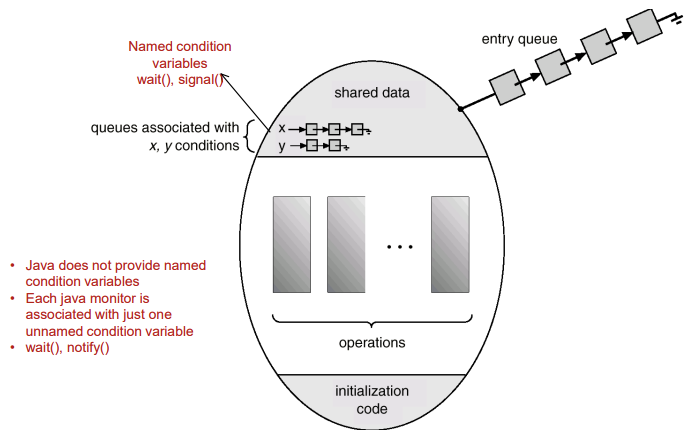
- 여러 operation들(method)이 있는데 어떤 프로세스가 해당 메소드를 실행할 때는 오로지 한 개씩만 실행이 가능하도록 제어해야 한다.
- Java에서는 named condition variables이 없고 오직 하나의 unnamed condition variable만이 있다.
Java Synchronization - 여기부터 쭉 XXXX
- Java provides rich set of synchronization features:
- Java monitors
- Reentrant locks
- Semaphores
- Condition variables
Java Monitors
- Concurrency mechanism for thread synchronization
- Every Java object has associated with it a single lock.
- If a method is declared as synchronized, a calling thread must own the lock for the object. (single thread can be active in a monitor)
- If the lock is owned by another thread, the calling thread must wait for the lock until it is released. (entry Q)
- Locks are released when the owning thread exits the synchronized method.
Bounded Buffer - Java Synchronization

Java Synchronization
- A thread that tries to acquire an unavailable lock is placed in the object’s entry set: (entry Queue)
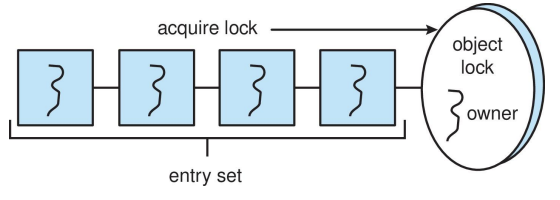
- Similarly, each object also has a wait set. (condition Queue)
- When a thread calls wait():
- It releases the lock for the object
- The state of the thread is set to blocked
- The thread is placed in the wait set for the object

-
A thread typically calls wait() when it is waiting for a condition to become true.
-
How does a thread get notified?
-
When a thread calls notify(): signal()이랑 동일
1. An arbitrary thread T is selected from the wait set-
T is moved from the wait set to the entry set
-
Set the state of T from blocked to runnable.
-
-
T can now compete for the lock to check if the condition it was waiting for is now true
Bounded Buffer - Java Synchronization
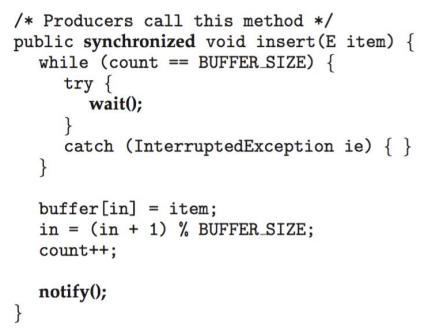
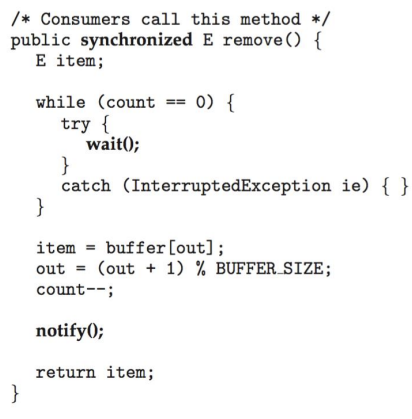
notify()를 바깥으로 뺀 이유는 try안에 있으면 wait() 실행 중에 error 발생시 catch로 넘어가서 nofity()를 실행하지 못하는 경우가 있을 수 있기 때문이다.
Java Reentrant Locks
- Similar to mutex locks
- The finally clause ensures the lock will be released in case an exception occurs in the try block.
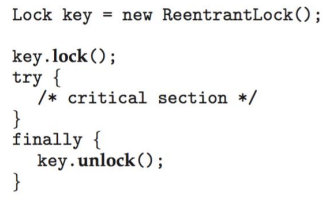
Java Semaphores
- Constructor:

- Usage:
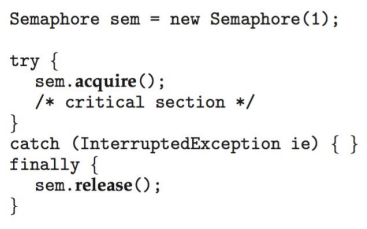
Java Condition Variables
-
condition variables provide similar functionality to wait() & notify()
-
To provide mutual exclusion, a condition variable is associated with an ReentrantLock. (java’s syncronized)
-
Creating a condition variable by first first creating a ReentrantLock: and invoking its newCondition() method of ReentrantLock:

-
A thread waits by calling the await() method, and signals by calling the signal() method of condition variable.
Monitor with condition variables
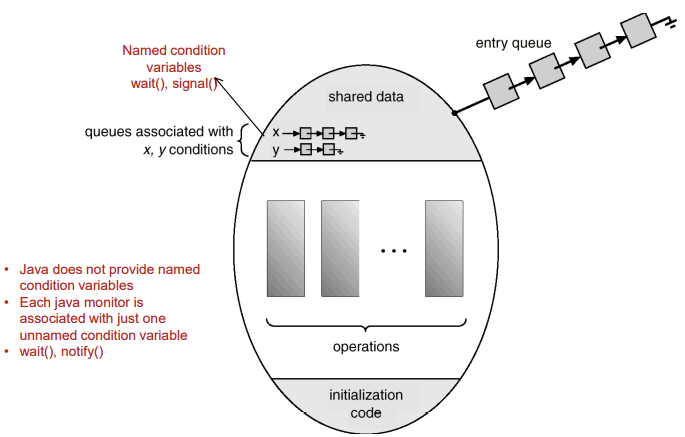
Java Condition Variables
- Example: Five threads numbered 0 .. 4
- Shared variable turn indicating which thread’s turn it is.
- Thread calls doWork() when it wishes to do some work.
- But it may only do work if it is their turn.
- If not their turn, wait
- If their turn, do some work for awhile ……
- When completed, notify the thread whose turn is next.
- Necessary data structures:

Java Condition Variables
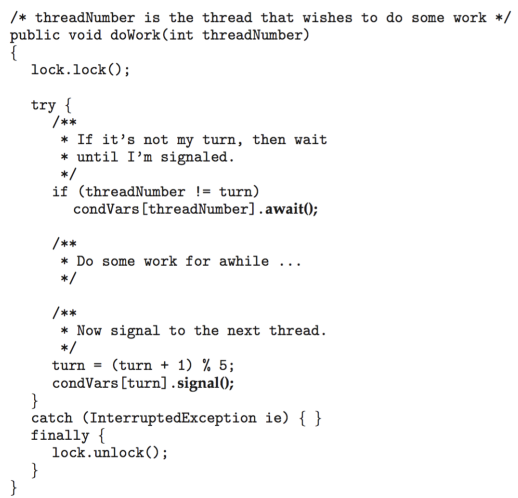
Alternative Approaches
- Transactional Memory
- OpenMP
- Functional Programming Languages
Transactional Memory
- Consider a function update() that must be called atomically. One option is to use mutex locks:
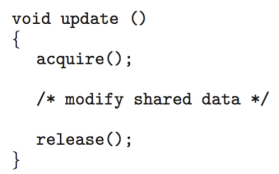
- Synchronization mechanism such as semaphores, mutex locks has deadlock and scalability problem, as the number of threads increases
- A memory transaction is a sequence of read-write operations to memory that are performed atomically. A transaction can be completed by adding atomic{S} which ensure statements in S are executed atomically:
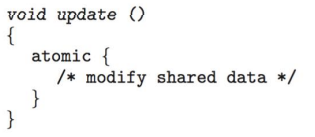
- Software transaction memory
- Implemented in software
- Hardware transaction memory
- Growth of multicore systems and emphasis on concurrent and parallel programming have prompted significant research in this area.
OpenMP
- OpenMP is a set of compiler directives and API that support parallel progamming.
- #pragma omp parallel
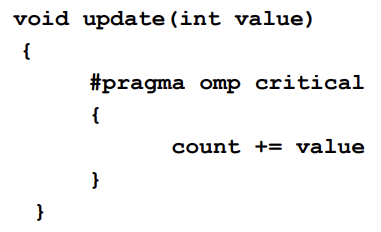
- The code contained within the #pragma omp critical directive is treated as a critical section and performed atomically.
Functional Programming Languages
- Imperative (procedure-oriented) language: C, C++, Java
- Functional programming languages offer a different paradigm than procedural languages in that they do not maintain state.
- Variables are treated as immutable and cannot change state once they have been assigned a value.
- There is increasing interest in functional languages such as Erlang and Scala for their approach in handling data races.

댓글남기기